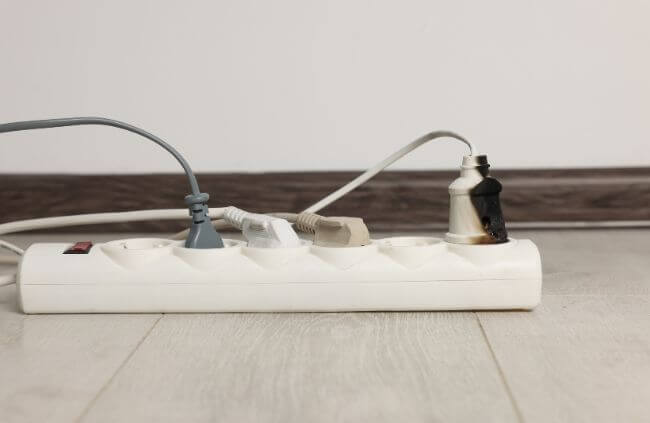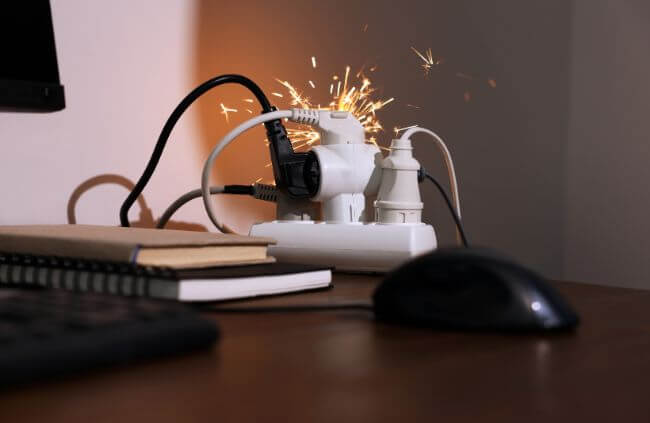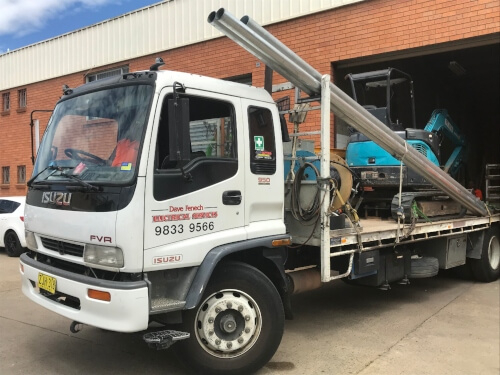Low voltage is not only an inconvenience but can also be a big problem. Understanding the cause of low voltage is essential as it might mean there are serious issues with your electrical system. Low voltage can cause your lights to dim and your appliances to not work properly.
Low voltage can make your energy bills go up and could even be a safety risk.

What is Low Voltage?
Low voltage happens when the electrical power in your home falls below the normal level needed for your devices. The usual voltage for homes should be between 220-240 volts. If the voltage drops well below this range, it can lead to poor performance and reduced efficiency of your electrical devices. Understanding the causes of low voltage helps address these issues effectively.
Knowing the specific demands of your appliances will help you spread out the electrical load evenly. This knowledge can help you manage how you use these devices, especially during peak hours.
What is the Danger of Low Voltage?
Low voltage is more than a small annoyance; it can lead to serious safety and financial problems. Here are some of the risks associated with a low voltage problem:
Appliance Damage
Appliances running on low voltage may be damaged. If the voltage is not sufficient, they cannot operate properly. This often leads to major breakdowns.
Electrical Shock
Low voltage problems can cause your electrical system to behave erratically. This inconsistent behaviour increases the likelihood of electric shocks. Electric shocks can be very dangerous.
Fire Hazards
When your home experiences low voltage, appliances and wiring may overheat. This is because they need to work harder to perform their functions. This added strain not only increases your energy bills but also increases the risk of electrical fires.
The Impact of Low Voltage on Your Appliances and Electronics
Low voltage can really affect how well your appliances and electronic devices work. Understanding the cause of low voltage in a house is critical for maintaining your devices.
When there is not enough voltage, things like refrigerators, air conditioners, and lights will not work correctly. Not only do they perform poorly, but also wear out faster. This means you will have to replace them sooner than you should have to.
To keep your home safe, regularly check that your electrical appliances and systems are not working too hard. Working too hard because of a low voltage problem can greatly increase the risk of overheating and fires.
Signs Your Home Might Have Low Voltage Issues
If you are experiencing some odd behaviour with your electrical devices, you might be dealing with low voltage. Taking early action by spotting signs of low voltage can stop problems from getting worse.
Here are some common symptoms to watch for that indicate your home may not be getting enough power.
- Flickering or Dimming Lights – Flickering light is often the first indication of low voltage.
- Appliances Performing Poorly – Appliances may not heat or cool efficiently. They may also operate slower than usual.
- Unexpectedly Shut Off – Electronic devices might shut down suddenly due to inadequate power supply.
- Unusual Noises – If you hear a buzzing or humming sound coming from an electrical device this may indicate it is struggling to get enough power.
- Slow Motors – Motors in appliances like washing machines or fans may run noticeably slower.
- Increased Energy Bills – Inefficient operation can lead to higher energy costs.
What are the Causes of Low Voltage in Homes?
Low voltage in a house can be caused by several different issues. Below are the most common reasons you may be experiencing a voltage drop.
- Overloaded Circuits – Plugging in too many devices on a single circuit can lead to a significant voltage drop.
- Faulty Wiring – Improperly installed, damaged, aged, and faulty wiring can increase resistance and reduce voltage.
- Distance from Power Source – The farther electricity must travel, the more potential there is for voltage drop.
- Defective Electrical Devices – Electrical devices that are defective may draw more power than rated. This can be the cause of low voltage in a house.
- Improper Wiring Size – If the wiring is not suitable for the current load, it results in a voltage drop. This is common when high-demand devices are used.
- Cause of Low Voltage in Outlets – Issues specifically within electrical outlets can also lead to low voltage problems.
- Causes of Low Voltage in Transformer – Physical issues with the transformer can significantly impact your voltage levels.
- What Causes Low Voltage at Light Switch – Issues at light switches can also contribute to overall low voltage issues in your home.

Diagnosing and Troubleshooting Low Voltage Issues
To fix low voltage problems, you need to figure out what is causing them. There are a few things you can do yourself. However, if you have any questions, it is important to call a professional for help.
The experts at Dave Fenech Electrical Services can provide a thorough inspection and address the cause of low voltage in your house.
Use a Multimeter
A multimeter is a tool that allows you to measure the voltage at different outlets and circuits around your home. This will help you identify if and where a low voltage issue might be occurring.
Inspecting the Electrical Panel
Regularly check your electrical panel for any signs of damage, such as burn marks or rust. Also make sure that no circuit breakers are tripped.
Examining Wiring and Circuits
Inspect wiring throughout your home to spot any visible signs of wear. Look for frayed or corroded wires and insulation damage. Damaged wiring and loose connections can cause low voltage and pose a safety risk.
Call a Professional
If problems persist or you find signs of serious electrical problems, it is best to call in experts. Dave Fenech Electrical Services offers professional assessments. These assessments can help ensure your home’s wiring is safe and functioning correctly.
Occasionally, the cause of low voltage might not be immediately apparent. These instances require a deeper look into the electrical system. This is where trained electricians are extremely important.
Experts like Dave Fenech Electrical Services can provide a thorough inspection that goes beyond surface-level fixes. We can identify your low voltage issues and rectify the causes.
Repairing and Upgrading the Electrical System
When you have low voltage problems, it is important to fix them right. A licensed electrician can update your system and make it safe.
- Repairing or Replacing Faulty Wiring – We will ensure all wiring is up to code and in good condition.
- Upgrading Electrical Infrastructure – Modern electrical systems are designed to handle today’s electrical demands.
- Redistributing Electrical Load – Install different circuits for different appliances. A high draw appliance should be on its own circuit.
- Installing a Voltage Regulator – These devices can stabilise the voltage across your home.
Preventing Voltage Drops and Electrical System Overload
To prevent low voltage problems, it is important to keep your electrical system in good shape.
- Regular Inspections – Have a trained electrician inspect your home’s electrical system periodically.
- Do Not Overload Circuits – Avoid using multiple high-energy-consuming appliances at the same time.
- Upgrade if Necessary – As your power demands grow, you may need to upgrade your system.
- Energy Efficient Appliances – Choose electrical devices that are energy efficient.
Energy Saving Tips to Maintain Stable Voltage
Managing how you use electricity can help keep the voltage in your home stable. Here are a couple of easy tips you can follow:
Spread Out the Use of Big Appliances
Try not to run large appliances like the dishwasher, dryer, or air conditioner all at once. Instead, use them one at a time. This is especially important during peak hours.
Turn Off What You Are Not Using
If you are not using it, turn it off. Keeping lights and other devices on when they are not being used can add extra load on your electricity. Not only will this help with voltage stability but can also lower your electric bill.
When to Call a Licensed Electrician
If you are having electrical issues like low voltage, it is best to call a licensed electrician. They have the right tools and knowledge needed to safely find and fix the cause of low voltage in a house.
Trying to handle electrical problems on your own can be dangerous. You could experience an electrical short or even a fire.
An experienced electrician will address low voltage problems correctly and safely. This can give you peace of mind knowing that everything is done properly.

The Dangers of DIY Electrical Fixes
Attempting DIY fixes on your home’s electrical system can be risky and may lead to serious consequences. Electrical work requires specific skills and knowledge.
Here is why you should think twice before taking on electrical projects yourself:
- Safety Risks – Working with electricity is extremely dangerous. Mistakes can lead to serious injuries such as electric shocks or even electrocution.
- Make the Problem Worse – Without proper training, it is easy to misdiagnose an electrical issue and make it worse.
- Code Violations – Electrical systems must comply with local building codes. These codes are designed to ensure safety. Unprofessional electrical work often violates standards.
- Potential Property Damage – Improper electrical work can increase the risk of fire. Poor connections, inappropriate materials, or overloaded circuits can all lead to overheating and cause a fire.
- Can Cost More – While DIY might seem like a good option, mistakes made can lead to expensive repairs. Hiring a professional after a failed DIY attempt usually costs more. This is because they must first correct the DIY errors.
Professional Help for Low Voltage: Call Us Today
Addressing low voltage is crucial for safety, efficiency, and longevity of electrical devices. For professional advice for addressing the cause of low voltage in your house, contact Dave Fenech Electrical Services.


